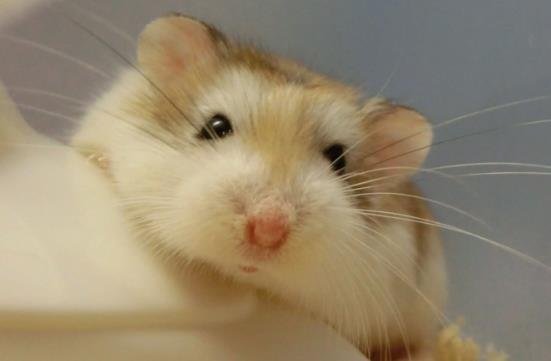Hamsters are small rodent pets cherished for their cute appearance, gentle temperament, and unique physical traits. Below are their main characteristics, covering size, appearance, behavior, physiology, and breed differences:

I. Size & Appearance Traits
Compact Size
Body Length: Typically 5–15 cm, varying by breed. For example, dwarf hamsters (e.g., Roborovski hamsters) are the smallest, while Syrian hamsters (teddy bear hamsters) are larger.
Weight: Adult hamsters weigh around 20–150 grams, with females usually slightly heavier than males.
Body Structure: Short, stocky torso; rounded belly; small limbs; and an extremely short, almost invisible tail.
Fur & Color
Fur Texture: Soft and dense, with both short-haired and long-haired varieties (e.g., long-haired Syrian hamsters).
Color: Diverse, including gold, gray, white, black, brown, and mottled patterns. Some breeds (e.g., Campbell’s dwarf hamsters) have distinct black stripes along their backs.
Seasonal Molting: Sheds fur in spring and autumn to adapt to temperature changes.
Head Features
Head Proportion: The head is large, accounting for about 1/3 of the body size.
Eyes: Round and protruding, with colors ranging from black, red to pink. Nocturnal hamsters have eyes better adapted to dark environments.
Ears: Short and upright with small ear flaps, sensitive to sounds.
Snout: Slightly blunt at the tip, with long, sensitive whiskers used to explore the surrounding environment.
II. Behavioral Habits
Nocturnality
Active Hours: Mainly active at night or dusk; spend most of the day hiding in nests to rest.
Adaptability: Under human care, they may gradually adjust to their owner’s schedule but remain highly active at night.
Food Storage Behavior
Cheek Pouch Use: Have expandable cheek pouches on both sides of the face, capable of storing large amounts of food (about 1/3 of their body weight) to bring back to the nest for later consumption.
Hiding Food: Tend to scatter and hide food in various spots around the cage, even burying it in bedding.
Territorial Instinct
Solitary Nature: Except for some dwarf hamsters (which can be kept in groups with sufficient space and resources to avoid fights), Syrian hamsters must be housed alone.
Marking Behavior: Mark their territory with urine and gland secretions.
Grooming Habits
Self-Cleaning: Frequently lick their fur to stay clean; owners do not need to bathe them often (water baths may cause stress).
Sand Bath Requirement: Need access to bathing sand to roll around in, which removes oil and parasites from their fur.
III. Physiological Structure Traits
Teeth & Chewing
Incisors: Have a pair of sharp incisors on both the upper and lower jaws that grow continuously. They need to gnaw on hard objects (e.g., chew stones, apple sticks) to keep the incisors short.
Molars: Used for chewing food. Hamsters’ diets must include hard grains to maintain dental health.
Digestive System
Diet: Omnivorous, feeding mainly on grains, seeds, and nuts, supplemented with small amounts of vegetables, fruits, and insect protein.
Fast Metabolism: Have a short digestive cycle (about 4 hours), requiring frequent feeding. Improper diets can easily cause diarrhea or constipation.
Sensory System
Smell: Rely on smell to find food, recognize companions, and avoid danger.
Hearing: Sensitive to high-frequency sounds and can communicate via ultrasonic waves (e.g., mother hamsters calling their pups).
Touch: Have well-developed tactile senses in their whiskers and paws, used to perceive the environment.
IV. Breed Difference Traits
Syrian Hamsters (Teddy Bear Hamsters)
Size: The largest breed, with a body length of 12–15 cm.
Fur Color: Gold, cream, black, brindled, etc.
Temperament: Gentle but solitary; must be housed alone.
Dwarf Hamsters (Winter White, Campbell’s, Roborovski)
Size: Smaller, with a body length of 5–10 cm.
Fur Color: Winter White dwarf hamsters have black stripes on their backs; Campbell’s dwarf hamsters have more distinct stripes; Roborovski hamsters are gray-white.
Temperament: Energetic; some varieties can be kept in groups (introduction to each other must be gradual).
Roborovski Hamsters (Robos)
Size: The smallest breed, with a body length of 4–5 cm.
Traits: Gray-white fur, large black eyes, agile movements, and easily startled.
V. Reproduction & Lifespan Traits
Reproductive Ability
Sexual Maturity: Females mature at around 4–6 weeks; males at 6–8 weeks.
Gestation Period: 16–22 days, with 4–12 pups per litter.
Reproductive Frequency: Females can have 3–5 litters per year, but frequent breeding shortens their lifespan.
Lifespan
Average Lifespan: 2–3 years (up to 3–4 years in human care).
Influencing Factors: Diet, environment, genetics, and medical care.
VI. Interaction Traits with Humans
Trainability
Training Potential: Can learn simple commands (e.g., spinning in circles, climbing onto hands) through food rewards.
Interaction Methods: Enjoy being petted on the back and head, but sudden movements should be avoided to prevent scaring them.
Emotional Expression
Relaxed State: Lies on its side, closes eyes, and flattens ears backward.
Alert State: Stands upright, tilts ears forward, and twitches whiskers.
Scared State: Curls up, trembles, and makes squeaking sounds.
Care Recommendations
Cage: Choose a spacious cage (at least 40cm × 30cm) equipped with an exercise wheel, tunnels, and hiding spots.
Diet: Provide specialized hamster food, supplemented with small amounts of fresh fruits and vegetables (avoid high-sugar, high-moisture foods).
Environment: Maintain a temperature of 20–28℃; replace bedding regularly to avoid odors and bacterial growth.
Health Monitoring: Observe feces, appetite, and activity levels; address abnormalities promptly (e.g., wet tail, hair loss).
